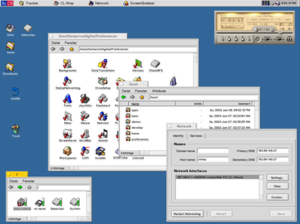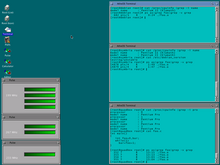BeOS
 | |
 BeOS R5 | |
| Developer | Be Inc. |
|---|---|
| Written in | C++ |
| Working state | Discontinued |
| Source model | Proprietary |
| Initial release | October 3, 1995 |
| Latest release | R5 / March 28, 2000 |
| Available in | English, Japanese |
| Platforms | IA-32 PowerPC |
| Kerneltype | Monolithic kernel[1] |
| License | Proprietary |
| Official website | beincorporated.com |
BeOSis a discontinuedoperating systemforpersonal computersthat was developed byBe Inc.[2]It was conceived for the company'sBeBoxpersonal computer which was released in 1995. BeOS was designed formultitasking,multithreading,and agraphical user interface.The OS was later sold toOEMs,retail, and directly to users; its last version was released asfreeware.
Early BeOS releases are forPowerPC.It was ported toMacintoshand thenx86.Be was ultimately unable to achieve a significant market share and ended development with dwindling finances, soPalmacquired the BeOS assets in 2001. Enthusiasts have since created derivate operating systems includingHaiku,which will retain BeOS 5 compatibility as of Release R1.
Development[edit]
BeOS is the product of formerApple Computer'sJean-Louis Gassée,with the underlying philosophy of building a "media OS" capable of up-and-coming digital media[3]and multi-processors. Development began in the early 1990s, initially designed to run onAT&T Hobbit-based hardware before being modified to run onPowerPC-based processors: first Be's ownBeBoxsystem, and later Apple Computer'sPowerPC Reference PlatformandCommon Hardware Reference Platform,with the hope that Apple would purchase or license BeOS as a replacement for its agingMac OS.[4]
The first version of BeOS shipped with the BeBox to a limited number of developers in October 1995. It supported analog and digital audio andMIDIstreams, multiple video sources, and 3D computation.[5]Developer Release 6 (DR6) was the first officially available version.
The BeOS Developer Release 7 (DR7) was released in April 1996. This includes full 32-bit color graphics, "workspaces" (virtual desktops), anFTPfile server, and aweb server.[6]
DR8 was released in September 1996 with a new browser withMPEGandQuickTimevideo formats. It supportsOpenGL,remote access,[7]andPower Macintosh.[8]
In 1996, Apple Computer CEOGil Ameliostarted negotiations to buy Be Inc., but stalled when Be CEOJean-Louis Gasséewanted $300 million[9]and Apple offered $125 million. Apple's board of directors preferredNeXTSTEPand purchasedSteve Jobs'sNeXTinstead.[10]
The final developer's release introduced a 64-bitfile system.BeOS Preview Release (PR1), the first for the general public, was released in mid 1997. It supportsAppleTalk,PostScriptprinting, andUnicode.[11]The price for the Full Pack was $49.95. Later that year, Preview Release 2 shipped with support for Macintosh'sHierarchical File System (HFS),support for 512MB RAM, and improvements to the user interface.[12]
Release 3 (R3) shipped in March 1998 (initially $69.95, later $99.95), as the first to be ported to theIntelx86platform in addition to PowerPC, and the first commercially available version of BeOS.[13]The adoption of x86 was partly due to Apple's moves, with Steve Jobs stopping the Macintosh clone market,[14]and Be's mounting debt.[15]
BeOS Release 4 has a claimed performance improvement of up to 30 percent. Keyboard shortcuts were changed to mimic those of Windows[16]However it still lacksNovell NetWaresupport.[17]It also brought additional drivers and support for the most commonSCSIcontrollers on the x86 platform - from Adaptec and Symbios Logic. The bootloader switched fromLILOto Be's own bootman.
In 2000, BeOS Release 5 (R5) was released. This is split between a Pro Edition, and a free version known as Personal Edition (BeOS PE) which was released for free online and by CD-ROM.[18]BeOS PE can be booted from within Windows orLinux,and was intended as a consumer and developer preview.[19][20]Also with R5, Beopen sourcedelements of the user interface.[21]Be CEO Gassée said in 2001 that he was open to the idea of releasing the entire operating system's source code,[22]but this never materialized.
Release 5 raised BeOS's popularity[18]but it remained commercially unsuccessful, and BeOS eventually halted following the introduction of a stripped-down version forInternet appliances,BeIA,which became the company's business focus in place of BeOS.[23]R5 is the final official release of BeOS as Be Inc. became defunct in 2001 following its sale toPalm Inc.A BeOS R5.1 "Dano", which was under development before Be's sale to Palm and includes the BeOS Networking Environment (BONE) networking stack,[24]was leaked to the public shortly after the company's close.[25]
Version history table[edit]
| Release | Date | Hardware |
|---|---|---|
| Developer Release 4 | Prototype | AT&T Hobbit |
| Developer Release 5 | October 1995 | PowerPC |
| Developer Release 6 | January 1996 | |
| Developer Release 7 | April 1996 | |
| Developer Release 8 | September 1996 | |
| Developer Release 9
(Advanced Access Preview Release) |
May 1997 | |
| Preview Release 1 | June 1997 | |
| Preview Release 2 | October 1997 | |
| Release 3 | March 1998 | PowerPCandIntel x86 |
| R3.1 | June 1998 | |
| R3.2 | July 1998 | |
| Release 4 | November 4, 1998 | |
| R4.5 ( "Genki" ) | June 1999 | |
| Release 5( "Maui" )
Personal Edition/Pro Edition |
March 2000 | |
| R5.1 ( "Dano" ) | Leaked | Intel x86 |
Hardware support and licensees[edit]
After the discontinuation of the BeBox in January 1997,Power Computingbegan bundling BeOS (on a CD-ROM for optional installation) with its line of PowerPC-basedMacintosh clones.These systems candual booteitherMac OSor BeOS, with a start-up screen offering the choice.[26]Motorolaalso announced in February 1997 that it would bundle BeOS with their Macintosh clones, theMotorola StarMax,along with MacOS.[27]DayStar Digitalwas another licensee.[28]
BeOS is compatible with many Macintosh models exceptPowerBook.[29]
With BeOS Release 3 on the x86 platform, the operating system is compatible with most computers that run Windows.Hitachiis the first major x86 OEM to ship BeOS, selling theHitachi Flora Priusline in Japan, andFujitsureleased the Silverline computers in Germany and theNordiccountries.[30]Be was unable to attract further manufacturers due to theirMicrosoftcontracts. Be closed in 2002, and sued Microsoft, claiming that Hitachi had been dissuaded from selling PCs loaded with BeOS. The case was eventually settled out of court for $23.25 million with no admission of liability on Microsoft's part.[31]
Architecture[edit]

BeOS was developed as an original product, with a proprietarykernel,symmetric multiprocessing,preemptive multitasking,and pervasivemultithreading.[32]It runs inprotected memorymode, with aC++application framework based on shared libraries and modular code.[8]Be initially offeredCodeWarriorfor application development,[32]and laterEGCS.
ItsAPIisobject oriented.The user interface was largely multithreaded: each window ran in its own thread, relying heavily on sending messages to communicate between threads; and these concepts are reflected into the API.[33]
BeOS uses modern hardware facilities such as modular I/O bandwidth, a multithreaded graphics engine (with theOpenGLlibrary), and a64-bitjournaling file systemnamedBFSsupporting files up to oneterabyteeach.[17]BeOS has partialPOSIXcompatibility and acommand-line interfacethroughBash,although internally it is not aUnix-derived operating system. Many Unix applications were ported to the BeOS command-line interface.[34]
BeOS usesUnicodeas the default GUI encoding, and support for input methods such asbidirectional textinput was never realized.
Applications[edit]
BeOS is bundled with a uniqueweb browsernamed NetPositive,[35]the BeMailemail client,[36]and the PoorManweb server[37].Be operated the marketplace site BeDepot for the purchase and downloading of software including third party, and a website named BeWare listing apps for the platform. Some third party BeOS apps include theGobe Productiveoffice suite,[17]theMozillaproject,[38][39]and multimedia apps likeCinema 4D.[40]QuakeandQuake IIwere officially ported, andSimCity 3000was in development.[41]
Reception[edit]
Be did not disclose the number of BeOS users, but it was estimated to be running on between 50,000 and 100,000 computers in 1999,[30]and Release 5 reportedly had over one million downloads.[18]For a time it was viewed as a viable competitor toMac OSandWindows,but its status as the "alternative operating system" was quickly surpassed byLinuxby 1998.[42]
Reception of the operating system was largely positive citing its true and "reliable" multitasking and support for multiple processors.[43]Though its market penetration was low, it gained a nichemultimediauserbase[30]and acceptance by the audio community. Consequently it was styled as a "media OS"[44]due to its well-regarded ability to handle audio and video.[45]BeOS received significant interest in Japan,[11]and was also appealing toAmigadevelopers and users, who were looking for a newer platform.[46]
BeOS and its successors have been used in media appliances, such as the Edirol DV-7 video editors fromRoland Corporation,which run on a modified BeOS[47]and the Tunetracker Radio Automation software that used to run it on BeOS[48][49][50]andZeta,and it was also sold as a "Station-in-a-Box" with the Zeta operating system included.[51]In 2015, Tunetracker released aHaikudistribution bundled with its broadcasting software.[52]
Legacy[edit]
The Tascam SX-1 digital audio recorder runs a heavily modified version of BeOS that will only launch the recording interface software.[53]TheRADAR 24, RADAR V and RADAR 6,hard disk-based, 24-track professional audio recorders from iZ Technology Corporation were based on BeOS 5.[54]Magicbox, a manufacturer of signage and broadcast display machines, uses BeOS to power their Aavelin product line.[55]Final Scratch,a 12-inch vinyl timecode record-driven DJ software and hardware system, was first developed on BeOS. The "ProFS" version was sold to a few dozen DJs prior to the 1.0 release, which ran on a Linux virtual partition.[56]
Spiritual successors[edit]

After BeOS came to an end, Palm createdPalmSourcewhich used parts of BeOS's multimedia framework for its failedPalm OS Cobaltproduct[57](with the takeover of PalmSource, the BeOS rights were assigned toAccess Co.[58]). However, Palm refused the request of BeOS users to license the operating system.[59]As a result, a few projects formed to recreate BeOS or its key elements with the eventual goal of then continuing where Be Inc. quit.
BeUnited, a BeOS oriented community, converted itself into anonprofit organizationin August 2001[60]to "define and promote open specifications for the delivery of the Open Standards BeOS-compatible Operating System (OSBOS) platform".[61]
ZETA[edit]
Immediately after Palm's purchase of Be, a German company namedyellowTABstarted developingZetabased on the BeOS R5.1 codebase and released it commercially. It was later distributed bymagnussoft.[62]During development by yellowTAB, the company received criticism from the BeOS community for refusing to discuss its legal position with regard to the BeOS codebase.Access Co.(which boughtPalmSource,until then the holder of the intellectual property associated with BeOS) declared that yellowTAB had no right to distribute a modified version of BeOS, and magnussoft was forced to cease distribution of the operating system in 2007.[63]
Haiku (OpenBeOS)[edit]
Haikuis a completeopen sourcereimplementation of BeOS. It was originally named OpenBeOS and its first release in 2002 was a community update.[62]Unlike Cosmoe and BlueEyedOS, it is directly compatible with BeOS applications. It is open source software. As of 2022, it was the only BeOS clone still under development, with the fourth beta in December 2022 still keeping BeOS 5 compatibility in its x86 32-bit images, with an increased number of ported modern drivers andGTKapps.[64]
Others[edit]

BlueEyedOS tried to create a system underLGPLbased on theLinuxkernel and anX serverthat is compatible with BeOS. Work began under the name BlueOS in 2001 and a demo CD was released in 2003.[65]The project was discontinued in February 2005.
Cosmoe, with an interface like BeOS, was designed by Bill Hayden as an open source operating system based on the source code ofAtheOS,but using theLinux kernel.[66][67][68]ZevenOS was designed to continue where Cosmoe left off.[69]
BeFree started in 2003, initially developed underFreeBSD[70]and laterLinux.[71][72]
See also[edit]
References[edit]
- ^"BeOS".RetrievedJanuary 13,2016.
- ^Finley, Klint (May 29, 2015)."This OS Almost Made Apple an Entirely Different Company".Wired.ISSN1059-1028.RetrievedJuly 1,2020.
- ^"Technical White Paper: The Media OS".May 25, 1997. Archived fromthe originalon May 25, 1997.RetrievedNovember 24,2023.
- ^Tom (November 24, 2004)."BeOS @ MaCreate".Archived fromthe originalon March 24, 2005.RetrievedNovember 16,2006.
- ^"Be Completes $14 million Financing".May 25, 1997. Archived fromthe originalon May 25, 1997.RetrievedNovember 24,2023.
- ^"Be Releases BeOS Version DR7".February 18, 1997. Archived fromthe originalon February 18, 1997.RetrievedNovember 24,2023.
- ^"Be Announces BeOS Version DR8".May 25, 1997. Archived fromthe originalon May 25, 1997.RetrievedNovember 24,2023.
- ^ab"Be Demonstrates BeOS for PowerMac".October 21, 1996. Archived fromthe originalon October 21, 1996.RetrievedNovember 24,2023.
- ^Tom, Hormby (August 10, 2013)."The Rise and Fall of Apple's Gil Amelio".Low End Mac.Cobweb Publishing, Inc.RetrievedMarch 28,2015.
- ^Owen W. Linzmayer (1999)."Apple Confidential: The Day They Almost Decided To Put Windows NT On The Mac Instead Of OS X!".Mac Speed Zone.Archived fromthe originalon June 24, 2013.RetrievedJanuary 18,2014.
- ^ab"Be Releases BeOS Preview Release To Developers".May 25, 1997. Archived fromthe originalon May 25, 1997.RetrievedNovember 24,2023.
- ^"Be Ships BeOS Preview Release 2".October 22, 1997. Archived fromthe originalon October 22, 1997.RetrievedNovember 24,2023.
- ^"ATPM 4.09 - Review: BeOS Release 3".www.atpm.com.RetrievedNovember 24,2023.
- ^"Be boss offers OS to OEMs for free".The Register. February 26, 1998. Archived fromthe originalon February 21, 2002.RetrievedNovember 24,2023.
- ^"Be Newsletters, Volume 3: 1998".Haiku.Be Inc. 1998. Archived fromthe originalon July 22, 2013.RetrievedJanuary 18,2014.
- ^"Be, Inc. Unveils BeOS Release 4 at COMDEX Fall 98".April 27, 1999. Archived fromthe originalon April 27, 1999.RetrievedNovember 24,2023.
- ^abc"A desktop alternative".Forbes.January 25, 1999.RetrievedNovember 24,2023.
- ^abc"Be Goes Platinum with BeOS 5".August 15, 2000. Archived fromthe originalon August 15, 2000.RetrievedNovember 24,2023.
- ^"Be Newsletters, Volume 5: 2000".Haiku.Be Inc. 2000. Archived fromthe originalon December 17, 2010.RetrievedJanuary 18,2014.
- ^"BeOS/Zeta".YellowBites.Archived fromthe originalon November 27, 2013.RetrievedJanuary 18,2014.
- ^"Be Opens Source Code to Desktop Interface of BeOS 5".April 12, 2001. Archived fromthe originalon April 12, 2001.RetrievedNovember 24,2023.
- ^"Be getting ready to open source BeOS?".The Register.February 3, 2001. Archived fromthe originalon February 3, 2002.RetrievedNovember 24,2023.
- ^"Be Newsletters, Volume 5: 2000".Haiku.Be Inc. 2000. Archived fromthe originalon July 22, 2013.RetrievedJanuary 18,2014.
- ^"Be Newsletters, Volume 5: 2000".Haiku.Be Inc. 2000. Archived fromthe originalon July 22, 2013.RetrievedJanuary 18,2014.
- ^Jake Daniels (January 23, 2002)."More Information on the BeOS Dano Version".OSNews.Archived fromthe originalon March 14, 2014.RetrievedJanuary 18,2014.
- ^"Be Newsletters, Volume 1: 1995-1996".Haiku.Be Inc. 1996. Archived fromthe originalon December 17, 2010.RetrievedJanuary 18,2014.
- ^Picarille, Lisa (February 24, 1997)."Motorola snubs NT, picks BeOS for its Mac clones".Computerworld.Vol. 31, no. 8. p. 12.
- ^"Be Announces BeOS Support for New Multiprocessor Systems".February 18, 1997. Archived fromthe originalon February 18, 1997.RetrievedNovember 24,2023.
- ^"BeOS Ready Systems -- PowerPC".January 27, 1999. Archived fromthe originalon January 27, 1999.RetrievedNovember 24,2023.
- ^abcLea, Graham (July 8, 1999)."Success expected for Be IPO".www.theregister.com.RetrievedNovember 24,2023.
- ^Mark Berniker (September 8, 2003)."Microsoft Settles Anti-Trust Charges with Be".Archived fromthe originalon November 9, 2013.RetrievedApril 24,2008.
- ^ab"Company Backgrounder"(PDF).gbnet.net.RetrievedMarch 13,2024.
- ^Potrebic, Peter; Horowitz, Steve (January 1996)."Opening the BeBox".MacTech.Vol. 12, no. 1. pp. 25–45.
- ^Brown (1998)
- ^"Ars Technica: Browsin' on BeOS - Page 1 - (9/99)".archive.arstechnica.com.RetrievedNovember 24,2023.
- ^"Ars Technica: E-Mail on the BeOS - Page 1 - (8/99)".archive.arstechnica.com.RetrievedNovember 24,2023.
- ^"The Poor Man's Web Server".
- ^Writer, CBR Staff (July 16, 1998)."BEZILLA FREE BROWSER FOR BEOS ON TRACK".Tech Monitor.RetrievedNovember 24,2023.
- ^"Bezilla: Mozilla for BeOS".www-archive.mozilla.org.RetrievedNovember 24,2023.
- ^"CINEMA 4D goes BeOS".testou.free.fr.RetrievedNovember 24,2023.
- ^"To Be Or Not To Be".Eurogamer.net.January 10, 2000.RetrievedNovember 24,2023.
- ^"Should you be in on Be Inc.'s IPO?".CNET.RetrievedNovember 24,2023.
- ^"CNN - Meet the challengers to Windows' throne - June 12, 1998".edition.cnn.com.RetrievedNovember 24,2023.
- ^Orlowski, Andrew."A Silicon Valley funeral for Be Inc".www.theregister.com.RetrievedNovember 24,2023.
- ^Writer, Henry Norr, Chronicle Staff (March 28, 2000)."Be Inc. Tries 'Open Source' System Version".CT Insider.RetrievedNovember 24,2023.
{{cite news}}:CS1 maint: multiple names: authors list (link) - ^CU Amiga.July 1998.
- ^"EDIROL by Roland DV-7DL Series Digital Video Workstations".Archived fromthe originalon November 10, 2006.RetrievedNovember 16,2006.
- ^Hacker, Scott (May 21, 2001)."BeOS And Radio Automation".Byte.com. Archived fromthe originalon November 22, 2001.RetrievedFebruary 14,2019.
- ^Vernon, Tom (June 4, 2002)."TuneTracker 2 Brings Automation to All".Radio World.RetrievedFebruary 14,2019.
- ^"Station to station".Computer Music.No. 82. Future plc. January 2005. pp. 68–73.ISSN1463-6875.
- ^"TuneTracker Radio Automation Software".Archivedfrom the original on November 14, 2006.RetrievedDecember 9,2006.
- ^Förster, Moritz (March 17, 2015)."Alternative Betriebssysteme: Haiku als USB-Distribution"(in German). iX Magazin.RetrievedFebruary 14,2019.
- ^"Professional Audio Coming to Haiku?".Haikuware.September 6, 2011. Archived fromthe originalon October 1, 2011.RetrievedJanuary 18,2014.
- ^"iZ RADAR 24".Archived fromthe originalon December 27, 2006.RetrievedDecember 27,2006.
- ^Jay Ankeney (May 1, 2006)."Technology Showcase: Digital Signage Hardware".Digital Content Producer. Archived fromthe originalon February 4, 2012.RetrievedDecember 9,2006.
- ^Peter Kirn (April 28, 2008)."Ni Ends Legal Dispute Over Traktor Scratch; Digital Vinyl's Twisty, Turny History".Create Digital Music.Archived fromthe originalon March 14, 2014.RetrievedJanuary 18,2014.
- ^PalmSource Introduces Palm OS Cobalt,PalmSource press release, February 10, 2004.ArchivedJuly 21, 2012, at theWayback Machine
- ^ACCESS Completes Acquisition of PalmSource,ACCESS press release, November 14, 2005.ArchivedJanuary 5, 2007, at theWayback Machine
- ^Orlowski, Andrew."Palm scuppers BeOS co-op hopes".www.theregister.com.RetrievedNovember 24,2023.
- ^"BeUnited - A global initiative aimed at professionally developing and marketing the BeOS".February 6, 2002. Archived fromthe originalon February 6, 2002.RetrievedNovember 24,2023.
- ^"beunited.org - Open Standards BeOS-compatible Operating Systems".April 8, 2005. Archived fromthe originalon April 8, 2005.RetrievedNovember 24,2023.
- ^abWhite, Bradford Morgan."'Be' is nice. End of story ".www.abortretry.fail.RetrievedNovember 24,2023.
- ^"Zeta Operating System".Operating System.org.October 14, 2013. Archived fromthe originalon March 14, 2014.RetrievedJanuary 18,2014.
- ^"R1/beta4 – Release Notes".Haiku Project.RetrievedDecember 24,2022.
- ^"BlueEyedOS Demo/Test CD Now Available – OSnews".www.osnews.com.RetrievedNovember 24,2023.
- ^"Interview with Cosmoe's Bill Hayden – OSnews".www.osnews.com.RetrievedNovember 24,2023.
- ^"IsComputerOn - Contact with Bill. (updated)".February 2, 2009. Archived fromthe originalon February 2, 2009.RetrievedNovember 24,2023.
- ^"Cosmoe Developer Seeks Successor – OSnews".www.osnews.com.RetrievedNovember 24,2023.
- ^"ZevenOS - Does it recapture the flavor of BeOS? | Linux Journal".www.linuxjournal.com.RetrievedNovember 24,2023.
- ^"BeFree 0.1.0 Released – OSnews".www.osnews.com.RetrievedNovember 26,2023.
- ^"About BeFree".December 3, 2003. Archived fromthe originalon December 3, 2003.RetrievedNovember 26,2023.
- ^"BeFree".August 13, 2004. Archived fromthe originalon August 13, 2004.RetrievedNovember 26,2023.
Further reading[edit]
- Brown, Martin C. (1998).BeOS: Porting UNIX Applications.Morgan Kaufmann.ISBN978-1558605329.
- Bortman, Henry; Pittelkau, Jeff (January 1997)."Plan Be".MacUser.Vol. 13, no. 1. pp. 64–72.
External links[edit]
- The Dawn of Haiku,by Ryan Leavengood, IEEE Spectrum May 2012, p 40–43,51-54.
- Mirror of the old www.be.com siteOther Mirror of the old www.be.com site
- BeOSCelebrating Ten Years
- BeGroovyArchivedSeptember 13, 2020, at theWayback MachineA blog and news archive for BeOS
- BeOS: The Mac OS X might-have-been,reghardware.co.uk
- Programming the Be Operating System:An O'Reilly Open Book
- BeOS Developer VideoonYouTube
- U.S. Trademark 78,558,039(BeOS)
